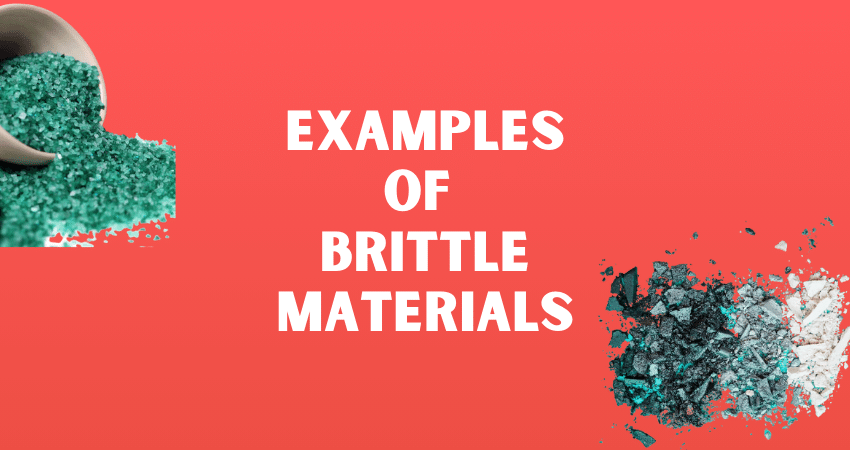Brittle materials are like that one friend who always cracks under pressure. These materials are known for their tendency to shatter when subjected to stress, making them the exact opposite of ductile materials that can stretch and bend without breaking. In this article, we’ll take a humorous and informative journey through 25 examples of brittle materials, from ceramics to sulfur.
What is a Brittle Material?
A brittle material is basically a “one-hit wonder.” It’s the type of stuff that can’t handle too much bending or stretching, deciding to throw in the towel with a dramatic shatter instead. The properties of brittle materials include low tolerance for deformation, high stiffness, and minimal energy absorption, which often leads to spectacular breakage.
The List of 25 Brittle Material Examples
Let’s plunge into the brittle world and get to know some of these delicate relations:
- Ceramics: The fancy dinnerware that pretends it’s fine but can’t handle a fall.
- Glass: Because it’s not a party until someone breaks a glass, right?
- Concrete: More like “cracks-crete” when it’s cold.
- Cast Iron: Not as “ironclad” as it sounds!
- Diamond: Sparkly, but also quite…hard to keep together.
- Graphite: Pencil leads can’t handle stage fright.
- Ice: It melts under pressure, but it shatters first.
- Porcelain: It’s like glassware’s sophisticated cousin.
- Quartz: The pretty mineral that’s all about those crystal-clear fractures.
- Stoneware: Imagine the pottery wheel is a talent show, and it’s a no-go.
- Tungsten: Known for its hardness, but also its ability to snap under the wrong circumstances.
- Zirconia: Pretty but not the most stable relationship.
- Bones: Your body’s internal comedy club. Laugh too hard, and they might break!
- Teeth: Don’t bite off more than you can chew, especially with brittle teeth.
- Egg Shells: The original fragile packaging.
- Seashells: Nature’s decor that crumbles in your hand.
- Plastics: Bend it too much, and it’ll remind you it’s not Gumby.
- Polymers: Plastic’s extended family, is equally fragile.
- Rubber: Elastic until it’s not.
- Wood: Sturdy until that one heavy thing decides to lean on it.
- Paper: Great for reading, not so great for acrobatics.
- Cardboard: Basically thick paper’s distant cousin.
- Asphalt: Just like our patience, it cracks under pressure.
- Coal: The fossil fuel that can’t handle criticism.
- Sulfur: It smells bad and is kind of a drama queen.
Different Types of Brittle Materials
Brittle materials come in various forms, each with its unique properties and applications. Understanding the different types can help you recognize them in everyday life. Some common categories of brittle materials include:
- Inorganic Brittle Materials: This category includes ceramics, glass, concrete, and metals like cast iron and tungsten. These materials are often used in construction and engineering.
- Organic Brittle Materials: Organic brittle materials encompass natural substances like bones, teeth, and seashells, as well as synthetic materials like plastics and rubber.
- Minerals: Many minerals, such as quartz and zirconia, exhibit brittleness due to their crystalline structures.
How to Identify Brittle Materials
Identifying brittle materials doesn’t require a degree in materials science. Here are a few characteristics to look for:
- Rigidity: Brittle materials are typically stiff and don’t bend easily.
- Lack of Plastic Deformation: They don’t change shape before breaking.
- Fragile Sound: When you tap them, they produce a characteristic, high-pitched, and fragile sound.
How to Test for Brittleness
If you want to determine whether a material is brittle, you can perform some simple tests:
- Bend Test: Try to bend the material gently. If it snaps without significant deformation, it’s likely brittle.
- Fracture Test: Apply a bit of force to a small piece. If it fractures with minimal deformation, it’s brittle.
- Sound Test: Tap the material and listen to the sound. A high-pitched, crisp sound often indicates brittleness.
How to Prevent Brittle Materials from Breaking
While we can’t change the nature of brittle materials, we can take precautions to prevent them from breaking prematurely:
- Proper Handling: Use care when working with brittle materials. Avoid sudden impacts, extreme temperature changes, or excessive force.
- Reinforcement: Sometimes, adding a supportive structure or combining brittle materials with ductile materials can enhance their durability.
- Temperature Control: Maintain stable temperature conditions to avoid thermal stress-induced breakage.
Case Studies of Brittle Materials Failures
It’s not all doom and gloom with brittle materials; they have their share of historical failures. Let’s look at a couple of interesting case studies:
- The Titanic Disaster: The Titanic’s hull plates were made of brittle materials like wrought iron and steel, which became susceptible to fracture in cold water. This contributed to the ship’s tragic sinking in 1912.
- The Glass Bridge Shatter: In 2016, a glass bridge in China made headlines when a tourist dropped a thermos, causing the bridge’s glass floor to shatter. The incident highlighted the brittle nature of glass.
These case studies remind us that understanding brittle materials is not only fascinating but also crucial for safety and engineering.
Conclusion
Brittle materials are all around us, sometimes hiding their fragility with a tough exterior. However, a little bit of stress, a sudden temperature change, or a drop can reveal their true, fragile selves. While these materials might seem a bit high-maintenance, they do have their uses. Just remember to handle them with care, and maybe, just maybe, you’ll avoid being the cause of their next dramatic exit.

